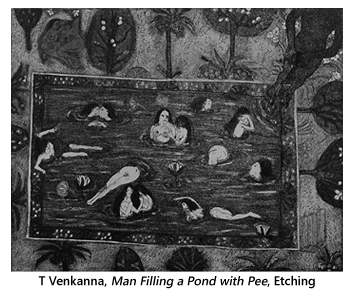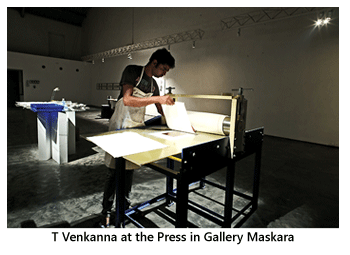- Publisher's Note
- Editorial
- Memories of a Master
- The Gallery as Print Studio
- Printer as Pedagogue
- Perspectives of an Outsider
- Ghosts in the Machines
- Digitalization and Contesting Digitalization
- The Body in Woodcut
- Evoking Symbol and Redefining Space
- The Almanac of Debian Delight
- Permanent State of Suspension
- Perspectives on Survival
- A Look at Printmakers from Australia, Canada and Bangladesh
- Atin Basak: His Artistic Pursuit
- Chor Bazaar, Mumbai
- Didn't We Often Wish We Lived in a Time of Ancient Glory
- The Buddhist Heritage of Pakistan: Art of Gandhara, the Asia Society Museum, New York
- Slivery Facets of Golden Diamonds from Golconda
- Ulysse Nardin: Keepers of History
- Venice Biennale
- What Happened with “Deconstruction India”
- Publication of Graphic Folio by the Members of Society of Contemporary Artists, 2010
- A Blitzkrieg of Creative Impulses
- Let's Paint the Sky Red- A Solo Show of Late Artist Manjit Bawa
- Raghu Rai: Invocation to India - A Variegated Matrix of the Human Predicament
- Rise of Prints
- The Story So Far
- What Happened and What's Forthcoming
- Art Bengaluru
- Art Events Kolkata
- Musings from Chennai
- Mumbai Art Sighting
- Few Printmakers from North East: A Brief Glance at the Contemporary Practices
- Previews
- In the News
ART news & views
The Gallery as Print Studio
Volume: 4 Issue No: 20 Month: 9 Year: 2011
An interview with T. Venkanna
by Sonia Nazareth
For seven weeks…from the 19th of July to the 4th of September…Gallery Maskara in Mumbai dissolved the hierarchy between the artist's studio (often seen as a sanctum for dynamic experimentation) and the gallery space (frequently experienced as a pristine white cube) by converting the gallery into an open studio for printmaking.
the gallery space (frequently experienced as a pristine white cube) by converting the gallery into an open studio for printmaking.
For the gallery this meant freedom from slavishly doing what galleries usually do: presenting works for viewership - all tidied up and purged of the chaos that characterizes dynamic creation. By opening up the gallery doors to viewers in an atmosphere of controlled informality and allowing them to engage with the remarkable processes of transferring a concept onto a wooden block or metal plate, audiences were encouraged to treat the gallery as they would a coffee shop, to do more than just flit in and out, to linger instead, to watch the spillages, to discuss the artistic journey, and in the process elicit thoughts and sensations that connected with their own life experience.
For the artist, ever interested in shuffling and combining methods and mediums from past and present until he finds a language which best reflects what he has to say, this was a chance to explore printmaking in the context of an engaged, if floating, audience…an audience who could observe that the process of fine-art printmaking is not, as popularly believed, a photographic reproduction but rather an evaporation of certainty, born by the nature of the medium itself. For each time a print is created by transferring ink from a metal plate or through a prepared screen onto a sheet of paper, a slightly different impression is born, each with its own unique DNA, greatly in contrast to those images made common by mass production for mass appeal.
The artist, T. Venkanna, sits before me, hunched over and intensely engaged with wooden blocks, copper plates, stencils, leather pads and rollers…forging a close relationship with the wealth of materials and processes that make printmaking unique in the field of fine art. What sets him apart from most printmakers is that he is not concerned with technical invention for its own sake. Venkanna is not a printmaker's printmaker, but rather an artist-printmaker who wishes to harness the soul and spirit of the medium to create works that are not dictated by quests for technological advancement or novelty. Instead, through delicate textures and reliefs and the use of strong lines, simple and complex drawing, he articulates his own deep-rooted concerns and preoccupations. In the world of T. Venkanna form is as important as line as texture as relief. Here's what he has to say about his ongoing love affair with the print medium.
Sonia Nazareth: Can you explain printmaking in the context of your larger practice?
Venkanna: I see printmaking as an integral part of my practice that includes drawing, painting, sculpture, installation, and performance. I work in several mediums including oils, acrylics, enamel, ink watercolor, charcoal, collage, paper mache, leather, gold, wood and foam. What draws me to printmaking is that the visual quality of a print is unique. I like its unpredictability because, as you know, aspects of the printmaking process are controlled by the medium itself.  I also appreciate the fact that this art form lends itself to experimentation, providing me with a myriad ways to say what I want to say. This happens through a multi-layered process that allows me to intimately engage with various materials - from the plate to the acid to the printing ink to the paper - to formulate my vision. But what connects all the mediums I use is my visual language and artistic concerns that remain constant irrespective of medium. I am often working across several mediums at any given time.
I also appreciate the fact that this art form lends itself to experimentation, providing me with a myriad ways to say what I want to say. This happens through a multi-layered process that allows me to intimately engage with various materials - from the plate to the acid to the printing ink to the paper - to formulate my vision. But what connects all the mediums I use is my visual language and artistic concerns that remain constant irrespective of medium. I am often working across several mediums at any given time.
SN: What is the relevance of a traditional medium like printmaking in the context of contemporary art practice such as new-media and installation art?
Venkanna: Printmaking techniques such as woodcut are ages old. They may have first developed in China, only to be fully established in Europe by the fifteenth century with the manufacture of paper and the introduction of typographical printing. But although artists like Durer, Rembrandt and Goya were written home about as the early masters, followed by others down the line like Picasso and Warhol, I find the use of old techniques neither intimidating nor passé. If anything, the incredible pictorial effects they achieved thorough extraordinary use of aquatints and powerful relief etchings in their printmaking inspires me. The beauty today is when these techniques are harnessed, developed and used to see the world with fresh eyes. For me it is never about "traditional" media or "new" media, but the transformation of the medium in the hands of the artist that gives it its contemporary edge. My visual language is not medium dependent. I choose the method and materials most relevant to express my idea.
SN: How do you see printmaking from a collector's perspective?
Venkanna: The main advantage to the collector is the accessibility of the medium, because prints are usually created in limited editions that are signed and numbered by the artist, and as a result they are often less-expensive than other single-edition works. This is a boon for the new collector as the prices of the works are comparatively low. This is also favourable for the more seasoned collector  who wants to expand his /her collection to include multiple forms of expression by the artists.
who wants to expand his /her collection to include multiple forms of expression by the artists.
SN: What are the various types of printmaking process?
Venkanna: There are three main techniques - all of which I am using in my present show: relief, intaglio and surface. Each print process has different linear and textural qualities, with distinctive artistic and expressive possibilities. Relief methods (such as woodcut) involve the removal of some surface areas, leaving raised areas to be inked with a roller. In intaglio techniques (such as etching, engraving, drypoint), an image is formed of engraved, carved or acid-bitten lines into a metal plate. These cavities are filled with ink and the contact of the plate on a sheet of damp paper under heavy pressure produces a print. Surface methods (such as lithography, stenciling, and monotypes), are those where the image is drawn on a flat plate or stenciled on a fabric screen.
SN: To a casual observer of your works it may seem that you are preoccupied with sex. I am sure you get this question from lots of people. How do you respond?
Venkanna: I am concerned with the representation of sexuality in society, which includes notions of beauty and the stereotypes that live around gender roles. I am not deliberately trying to shock or provoke the viewer. I would say my image-making explores the trope of power and violence through the lens of sexual acts. The interaction between nature and culture is another concern that frequently comes through in my works.
SN: You use a lot of text and symbols in your work across all mediums including prints. Can you explain why?
Venkanna: I use text both consciously and subconsciously. Sometime it has literal meaning and at other times it is used simply as a pictorial device - for visual and compositional reasons. I often use arrows, numbers and words to highlight certain key aspects of the work. Sometimes it may not even be obvious to the viewer that they have been used, but if you look at the work closely you do see them.
SN: Do you think about size and scale before you begin a work? What about titles?
Venkanna: The size of a work is only as important as the idea it represents, so I don't think about scale as a separate decision.  I usually choose the format that is most appropriate for the overall form that I want to create. The title and the signature is the last step in the creative process. Once done, it allows me mentally to move on to newer works. I think of it as an act of completion. In general my titles are quite straightforward and refer to some aspect of the image.
I usually choose the format that is most appropriate for the overall form that I want to create. The title and the signature is the last step in the creative process. Once done, it allows me mentally to move on to newer works. I think of it as an act of completion. In general my titles are quite straightforward and refer to some aspect of the image.
SN: Do you make preparatory drawings before you begin your work?
Venkanna: When I'm making prints, I usually work directly on the surface at hand. However at other times I may be often found making freehand drawings on small sheets of paper. It is convenient and I can do it anywhere - in the train, on restaurant napkins, on the potty (he giggles). Most remain as drawings but some are preparatory sketches for larger works in other mediums.
SN: Do you think that it is the artist's responsibility to explain his work?
Venkanna: I am not sure if artists are fully capable of finding and arranging the right words to talk about their works. I am not even sure that works of art require explanation. Maybe some conceptual works do, but by-and-large I think works should speak for themselves. They should start a dialogue with the viewer and engage him or her at an emotional, psychological and spiritual level.